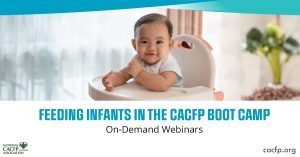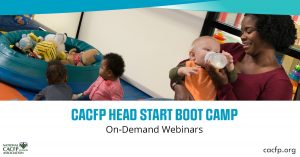Boot Camp
Feeding Infants in the CACFP: Resources, Training and Regulations ($)
If you are caring for infants at your site, you know there are additional requirements when feeding infants which change as they move from 0-5 months of age to 6-12 months. There are also many resources! Learn how to use and reference the USDA’s Feeding Infant Guide to support your care, protocols, and participation in the food program.
Read MoreDefining Developmentally Ready, Engaging Parents, and Understanding Cues ($)
Coordination and muscle control are key skills infants need to be ready to eat solid foods, but what are the signs and resources you need to help you know? Having parents part of the conversation on what their baby is eating at child care can help bridge the gap between healthy eating practices at home and at child care.
Read MoreCACFP Infant to Toddler Meal Patterns Quizapalooza ($)
Maybe you are new or have been working in the CACFP for quite some time. But are you a CACFP Infant Meal Pattern Superstar? This fun, interactive session will test your knowledge in the CACFP meal patterns specific to infants and fill in the details of what you may not know!
Read MoreEmergency Preparedness in Head Start ($)
The pandemic taught us to always be one step ahead and prepared for the unknown. Discover ways to integrate emergency preparedness and planning into your facility operation plans while including all departments. Practice writing your own emergency plans to support your program and outline your next steps.
Read MoreA Change of Taste: Reducing Sodium in the CACFP ($)
Sodium plays an essential role in our body but consuming too much can cause us harm over time. In the CACFP, it is recommended to serve foods low in sodium. Learn about the the impacts of sodium and how to reduce sodium while still retaining flavor in the meals you serve.
Read MoreUnderstanding Meal Modifications in the CACFP ($)
Have you ever received a parent’s or doctor’s note describing a meal modification or substitution to serve a child in your care? Maybe you
have felt confused or overwhelmed on how to modify the menu to ensure foods are safe to serve to a participant with a disability. Learn about the requirements for having a medical statement to serve safe and reimbursable foods in the CACFP. Identify creditable and non-creditable milk substitutions in the CACFP and understand the documentation needed. Gain valuable knowledge on tailoring foods for special diets, including vegetarian, pureed, and gluten-free diets. Empower yourself with the information and guidance to confidently address meal modifications and provide suitable options for participants with specific dietary needs in the CACFP at your Head Start site.
Fueling Healthy Growth in Early Head Start ($)
Early Head Start sites must often manage two different meal patterns when complying with CACFP requirements based on the age of the children in their care. Learn the differences between feeding infants and toddlers to ensure optimal nutrition and program compliance. Gain valuable insights on how to create balanced and age-appropriate menus, address specific dietary considerations for infants, and implement practical strategies for promoting healthy eating habits to foster a positive mealtime environment.
Read MoreCivil Rights Complaint Procedures ($)
It’s a requirement for operators of CACFP to ensure non-discrimination in the administration of the program and knowing how to establish a written procedure for handling civil rights complaints related to discrimination is important. Gain a comprehensive understanding of the Civil Rights Complaint Procedures and learn how to develop a Self-Assessment Checklist, essential components for compliance. Enhance your knowledge, strengthen your agency’s commitment to civil rights in the CACFP, and be inspired by a real-life example showcasing the successful execution of these procedures.
Read MoreMeal Patterns 101 ($)
Head Start centers play a critical role in serving nutritious foods to those they serve. The CACFP guides you on how to provide healthy meals using five food components which make up the meal service requirements: grains, fruits, vegetables, meats/meat alternates and milk. Learn when these components are required and how they fit into the CACFP meal pattern.
Read MoreMastering Head Start Menus in the CACFP ($)
Navigating the complexities of developing a CACFP Head Start menu can often be overwhelming and confusing. What crucial information should
you include on the menu to be in compliance? Do you include ounce equivalency, serving size, or both!? Moreover, are there specific documents you should maintain while planning your menu? Learn how to create menus stress-free while meeting CACFP requirements in Head Start as we guide you through the process. Get confidence and clarity in your menu development endeavors.


